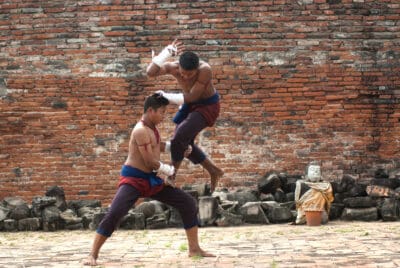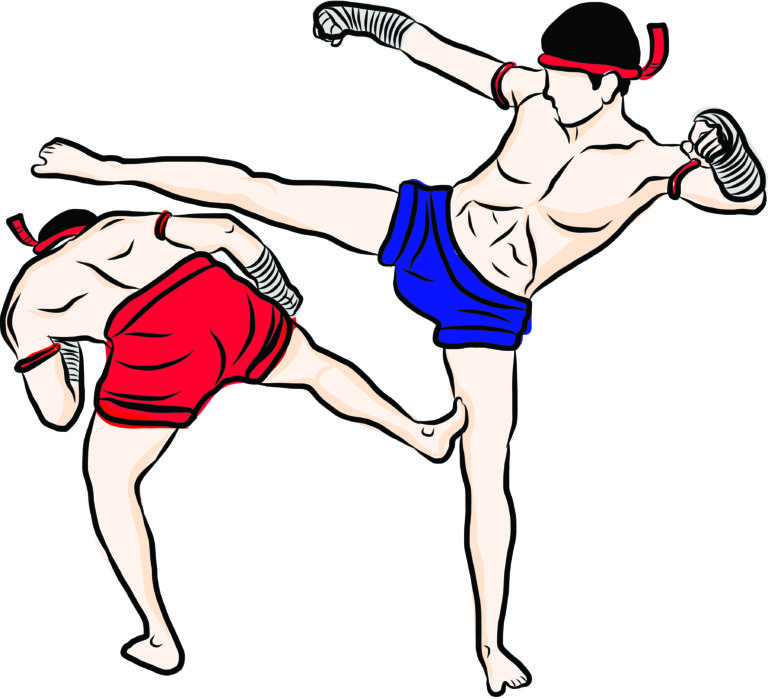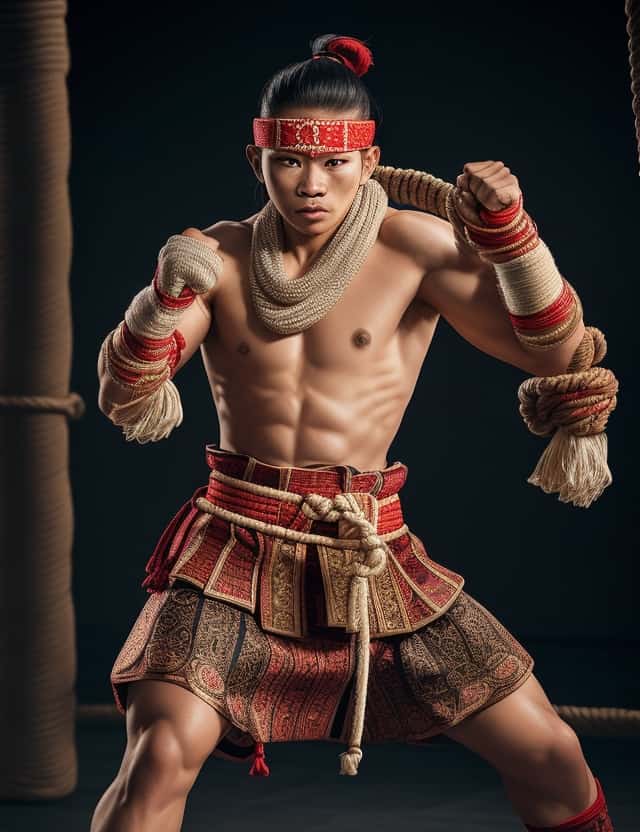In this post we will go over in detail the powerful and effective muay boran techniques and how these are trained in muay boran.
Muay Boran is based off of fundamental techniques that have been handed down for generations beginning back in the Ancient history of Thailand and the region of South East Asia.
In today’s modern muay thai, based on combat sport rules, we can still see some semblance off the much older Muay Boran techniques.
But being restricted by rules and regulations, muay thai still differs greatly from its original form in Muay Boran.
So let’s get into Thailand’s Ancient Boxing and the techniques that made this style effective in the battlefields of the warring period of the Siam Kingdom dating back hundreds if not thousands of years.
What is Muay Boran?
Muay Born translates literally to mean’Ancient Boxing’ and it was the unarmed fighting system of Ancient Siamese warriors that was used in the battlefield.
Outside of warfare, muay boran was developed as a system to organize contests to choose the best of the warriors who were then selected as the King’s guards.
Muay Boran is also known as the Art of 9 Limbs due to the inclusion of headbutts as part of the muay boran techniques used in combat.

Styles of Muay Boran
Muay Boran is an ‘umbreall term’ that includes different styles of boxing associated with different regions of. Thailand.
These styles in themselves are distinct and unique and include their own systems of fighting, techniques and training methods.
Each of these Muay Boran styles carries with it a rich history and a distinct set of techniques, reflecting the diverse traditions and regional influences that have shaped Thai martial arts over the centuries.
Muay Thasao (Muay Korat)
Hailing from the Korat region of Thailand, Muay Thasao emphasizes strong and forceful strikes.
Known for its devastating elbow and knee techniques, this style is highly effective in close-quarters combat.
Practitioners of Muay Thasao often utilize powerful sweeps and throws to overpower their opponents, making it a formidable style in the arena.

Muay Chaiya
Originating from the southern provinces of Thailand, Muay Chaiya is renowned for its defensive techniques and evasive footwork.
This style emphasizes fluid movements and uses the opponent’s energy against them.
Muay Chaiya practitioners employ intricate hand techniques and counterattacks, making it a style that requires exceptional timing and skill.
Muay Korat (Muay Tum)
Hailing from the Korat region like Muay Thasao, Muay Korat is characterized by its aggressive and relentless approach to combat. With a focus on powerful kicks and devastating strikes, Muay Korat fighters are known for their ferocity and unyielding spirit in the face of adversity.
Muay Lopburi
Originating from the Lopburi region, Muay Lopburi emphasizes swift and precise movements.
This style incorporates a wide range of techniques, including powerful punches, swift kicks, and crafty elbow strikes.
Muay Lopburi practitioners are known for their strategic approach, blending offense and defense seamlessly.
Does Muay Boran have Grappling?
While Muay Boran is often known for its striking techniques, it is a comprehensive martial art that includes various aspects of combat, and grappling is one of them.
In Muay Boran, practitioners are trained in close-quarters techniques that involve clinching, throwing, sweeping, and controlling opponents on the ground.
The clinch, where fighters engage in close contact and attempt to control each other’s bodies, is a significant aspect of Muay Boran’s grappling component.
From the clinch, practitioners can deliver devastating knee strikes, sweeps, and takedowns.
Grappling in Muay Boran is not the same as modern Brazilian Jiu-Jitsu or wrestling, but it incorporates elements of clinching and ground control to neutralize opponents and gain a dominant position.
While the primary focus is on striking, the inclusion of grappling techniques makes Muay Boran a well-rounded and effective martial art that caters to a wide range of combat scenarios.
It’s important to note that the extent and depth of grappling in Muay Boran can vary based on the lineage, instructor, and training curriculum.
Some schools may place more emphasis on grappling techniques, while others might focus more on striking and other aspects of the art. Nonetheless, grappling is a legitimate and integral part of Muay Boran, contributing to its historical significance and overall effectiveness as a martial art.
Does Muay Boran have Weapons?
Yes, weapons training is traditionally a part of Muay Boran.
Historically, Muay Boran practitioners in ancient Thailand were not only skilled in unarmed combat but also trained in the use of various traditional Thai weapons.
The weapons training aspect of Muay Boran is known as “Krabi Krabong.”
Krabi Krabong involves learning how to handle and fight with weapons such as:
- Krabi (Staff): The staff is a versatile weapon that allows for both defensive and offensive techniques. Practitioners learn strikes, blocks, and sweeping techniques with the staff.
- Daab Song Mu (Double Swords): Double swords require a high level of skill and coordination. Training includes various slashing, thrusting, and parrying techniques.
- Daab Song Ngu (Double Daggers): Double daggers are short blades that practitioners use to execute swift and lethal attacks at close range.
- Daab (Sword): Single-sword techniques involve precise cutting and thrusting movements, along with defensive maneuvers.
- Ngao (Halberd/Glaive): The ngao is a polearm weapon with a blade and hook. Training includes sweeping, thrusting, and disarming techniques.
- Sai (Dagger/Knife): The sai is a short weapon with two prongs. Training includes strikes, blocks, and disarming techniques.
- Chabang Kraw (Pole Baton): The chabang kraw is a long pole used for both striking and blocking.
The inclusion of weapons training in Muay Boran served practical purposes in ancient times, as warriors needed to be proficient in armed combat for self-defense and protection on the battlefield.

It also complements the unarmed techniques, as many principles and strategies from weapon forms carry over into the empty-hand techniques of Muay Boran.
While the emphasis on weapons training may vary among different Muay Boran schools and instructors, traditional training includes both armed and unarmed techniques, showcasing the rich martial heritage of ancient Thailand.
4 Main Components of Muay Boran Techniques
The four fundamental components of Muay Boran encompass the core aspects that make up this ancient Thai martial art.
These components are the building blocks of a comprehensive and well-rounded system:
Striking Techniques
Striking forms the backbone of Muay Boran.
Nawarthawooth in Thai is are the techniques of the 9 Limbs and are all about striking.
It involves using various parts of the body as weapons, such as fists, elbows, knees, shins, and feet, to deliver powerful and precise blows to an opponent.
Striking techniques in Muay Boran are diverse, ranging from fast and agile punches to devastating kicks and knee strikes.
The art places significant emphasis on developing strong, accurate, and versatile striking skills to engage opponents both up close and at a distance.
Clinching and Grappling
Clinching refers to the close-quarters grappling and wrestling techniques in Muay Boran.
It involves controlling an opponent’s body, especially the neck and arms, to set up strikes, throws, and sweeps.
The clinch is a crucial component of Muay Boran, allowing fighters to dominate their opponents in close-range combat and neutralize their attacks effectively.
Locks and Holds
Muay Boran includes a range of joint locks, holds, and submissions to immobilize and control opponents.
These techniques are typically used in combination with clinching and grappling to subdue and incapacitate opponents without causing severe injury.
Locks and holds are essential for self-defense situations and for maintaining control during the heat of combat.
Weapons Training
Historically, Muay Boran practitioners were trained in the use of traditional Thai weapons.
This component includes techniques and strategies for wielding weapons such as the staff (staff-fighting is called “Krabi Krabong“), sword, spear, and other traditional arms.
While weapons training is not as prevalent in modern Muay Boran practice, it remains an essential part of the art’s historical roots and adds depth to a practitioner’s understanding of traditional Thai martial culture.



